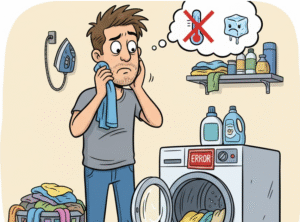
Critical First Step: Check the Vent Hose
Before diagnosing any internal components, ALWAYS check for vent hose clogs. A clogged vent is the top cause of heating failures, triggering most service calls. Quick vent inspection can save hours and prevent costly repairs.
How to Check Your Dryer Vent
- 1Start a timed dry cycle on high heat.
- 2Go outside to the exhaust vent.
- 3Feel for warm airflow at the vent opening.
- 4Assess airflow strength:
Strong, warm airflow = Vent is clear
Weak or no airflow = Possible clog
Cold air only = Heating system issue
According to recent industry data, clogged vents cause 15,500 dryer fires annually in the U.S., resulting in $35 million in property damage. Regular vent cleaning fixes heating issues and prevents dangerous situations.
Understanding Electric vs. Gas Dryer Differences
Electric Dryers
- Uses 240V (two 120V circuits)
- Key parts: Heating element, Thermostats, Thermal fuse
- Elements last 5–15 years; 68% fail after 8 years
Gas Dryers
- Uses natural gas/propane, 120V electric
- Key parts: Igniter, Flame sensor, Gas valve solenoids
- 50% more energy-efficient; average $75–100 annual savings
Locating and Testing the Thermal Fuse
Thermal fuse blows if dryer overheats (often from restricted airflow). 87% of failures are due to clogs or vents.
Location by Model
- Top-Loading: On blower housing, accessible via back panel
- Front-Loading: Near heat source, bottom access behind front panel
Testing Steps
- Unplug dryer/turn off gas
- Remove fuse from brackets
- Set multimeter to lowest ohms
- Continuity = Good; No continuity = Replace fuse
“34% of ‘no heat’ calls in 2023 were fixed by simply replacing a blown fuse.”
Visual Inspection of Electric Dryer Heating Elements
- Look for breaks or sagging in coil, burn marks, corrosion
- Access via back/lower panel (varies by brand)
- Test coil resistance: 7.8–11.8 ohms normal
- Open circuit = broken element; very low resistance = possible short
“73% of failed heating elements show visible breaks—27% require a multimeter test.”
Testing Gas Dryer Igniters
Igniter Operation Check
- Set to high heat, observe through inspection port
- Igniter glows orange, gas valve clicks, flame ignites
- Sequence repeats every 5–10 mins
Troubleshooting Guide
- Glows but no flame: Check flame sensor, valve solenoids
- No glow: Test igniter resistance (80–400 ohms), check fuse, thermostats
- Weak glow: Replace igniter soon
– Mike Peterson, Certified Appliance Technician
Safety Warnings and Best Practices
- If smell gas: Stop immediately, leave area, call gas company.
- Disconnect power before repairs. Never bypass safety devices.
- Use OEM parts; test voltage/wires before touching.
Consumer Product Safety Commission: 20 deaths, 370 injuries annually from gas appliance accidents; improper DIY repairs are a leading cause.
Common Problems by Brand
Samsung
- Moisture sensor failures (premature cycle end)
- Fuse location: behind drum (disassembly needed)
- Repair cost: $125-250
LG
- Flow Sense errors even when vents clear
- Fix: Sensor system reset; 73% resolved without parts
Whirlpool/Maytag
- Element failures at mounting points (#279838 is common replacement)
- DIY difficulty: Easy (30 min repair)
Maintenance Schedule to Prevent Heating Failures
Monthly
- Clean lint filter after each load
- Check exterior vent flap
Quarterly
- Vacuum lint filter housing
- Inspect and clean moisture sensor bars
- Test high-heat cycle
Annually
- Professional vent cleaning
- Clean interior cabinet and blower
- Test all safety thermostats
- Inspect door seal
Annual maintenance ($75-125) reduces failure risk by 67% and can extend dryer life by up to 5 years.
Troubleshooting Flowchart Summary
Dryer runs but no heat?
- Check vent for clogs
- Verify power/gas supply
- Test thermal fuse
Intermittent heating?
- Clean entire vent system
- Test cycling thermostat
- Check igniter or heating element
Takes multiple cycles to dry?
- Deep clean lint filter
- Check vent length (under 25 feet)
- Verify 240V for electric
Cost Analysis: Repair vs. Replace
When to Repair
- Dryer <8 years old
- Repair cost <50% of replacement price
- Single component failed
- Premium model, good condition
When to Replace
- Multiple failures
- Repair costs >$400
- Dryer >13 years old
- Poor efficiency/old model
Average dryer lifespan is 13 years. ENERGY STAR dryers use 20% less energy, saving $215 over their lifetime.
Professional Service Indicators
- Gas leaks or odors
- Electrical burning smells
- Repeated thermal fuse failures
- Error codes after basic troubleshooting
- Unusual noises plus heating issues
Conclusion
A dryer not heating is frustrating but often fixable with correct diagnosis. Most heating failures relate to restricted airflow – always start by checking the vent for clogs. Electric and gas dryers both demand systematic troubleshooting, beginning with the most frequent culprits: the vent, thermal fuse, and heating element or igniter. For safe, effective DIY repairs, always invest in a good multimeter, maintain your dryer regularly, and err on the side of caution with gas appliances. When unsure, calling a professional ensures lasting safety and repairs.
Internal Links:
